Scaffolding Couplers Types: A Comprehensive Guide
In construction and industrial projects, scaffolding couplers play a crucial role in ensuring safe, stable, and versatile scaffolding structures. These essential components connect scaffolding tubes and frames, allowing for flexible configuration of scaffolding structures that can support workers, materials, and tools at various heights and positions. Understanding the different types of scaffolding couplers is vital for selecting the right one for each project, ensuring safety, compliance, and efficiency.
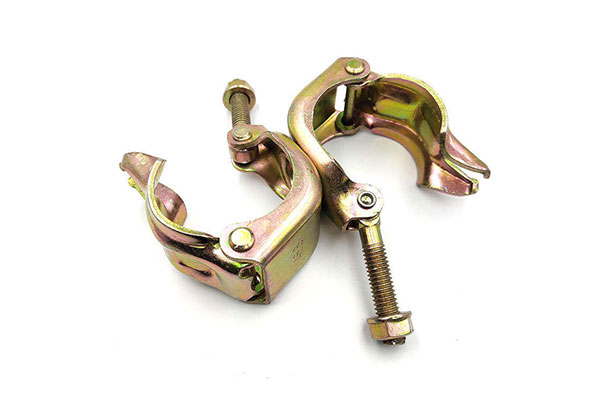
What Are Scaffolding Couplers?
Scaffolding couplers are metal connectors that secure scaffolding tubes to form the framework of a scaffold. Made from durable materials such as steel or alloy, couplers are engineered to bear substantial weight and resist environmental stresses. Different types of couplers are available to accommodate various structural needs and to meet local construction standards and requirements.
Common Types of Scaffolding Couplers
There are several types of scaffolding couplers, each serving specific purposes and load capacities. Here’s a breakdown of the main types of scaffolding couplers and their uses:
1. Right-Angle Couplers (Double Couplers)
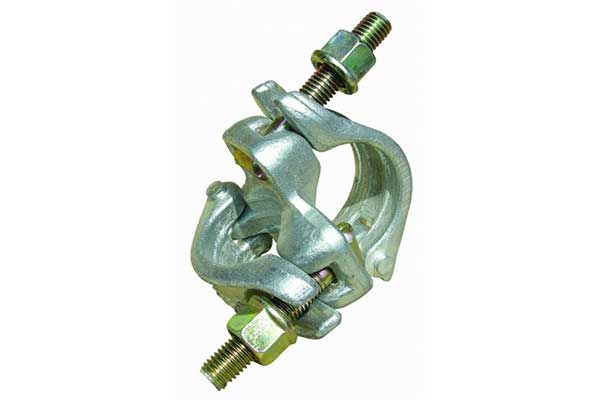
Right-angle couplers, also known as double couplers, are one of the most common types of scaffolding couplers. They are used to connect two scaffold tubes at a 90-degree angle, forming a strong and stable joint for main scaffold structures. These couplers are primarily used in load-bearing applications, such as forming the basic framework or “standard” of the scaffold, as they provide a secure connection and resist torsion.
Key Features:
- Strong load-bearing capacity
- Excellent for vertical and horizontal connections
- Essential for primary structural stability
2. Swivel Couplers
Swivel couplers allow two scaffold tubes to be joined at various angles, providing flexibility in scaffold design. Unlike right-angle couplers, swivel couplers are not limited to 90-degree angles and are ideal for diagonal bracing. This type of coupler is crucial in situations where the scaffold must be adapted to a specific structure or to fit irregular surfaces.
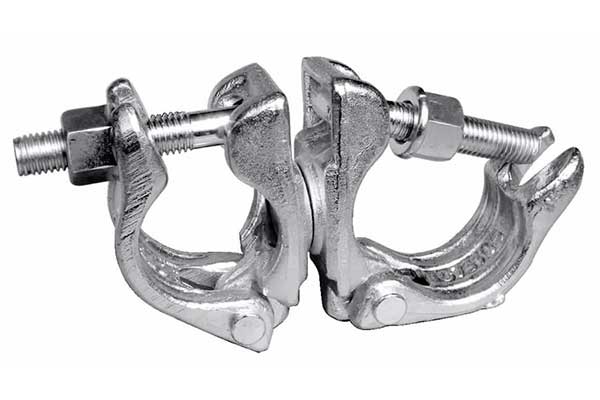
Key Features:
- Allows angle adjustments, ideal for irregular structures
- Supports complex configurations and bracing
- Enhances the scaffold’s flexibility and adaptability
3. Putlog Couplers (Single Couplers)
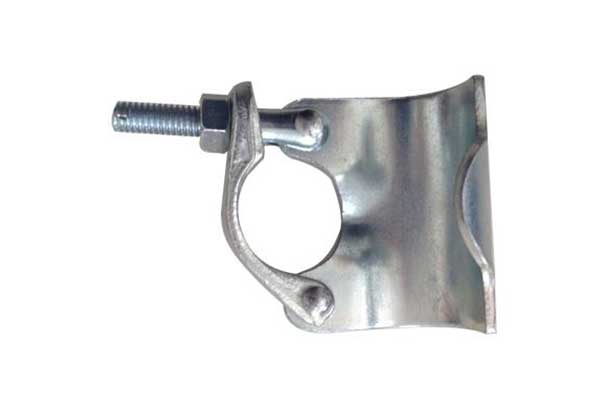
Putlog couplers, or single couplers, are used to connect a scaffold tube to a horizontal member (putlog) or ledgers to standards. Unlike double couplers, putlog couplers have a single grip point, which means they aren’t as strong but are perfect for non-load-bearing applications. They are commonly used to create working platforms where additional support isn’t necessary.
Key Features:
- Best for lighter, non-load-bearing connections
- Cost-effective option for creating stable platforms
- Primarily used in putlog scaffolding systems
4. Sleeve Couplers
Sleeve couplers are designed to join two scaffolding tubes end-to-end, extending the length of the scaffold. They are essential for adding length to the scaffolding framework without compromising its stability. Sleeve couplers feature a sleeve-shaped design and often come with built-in reinforcement for added safety.
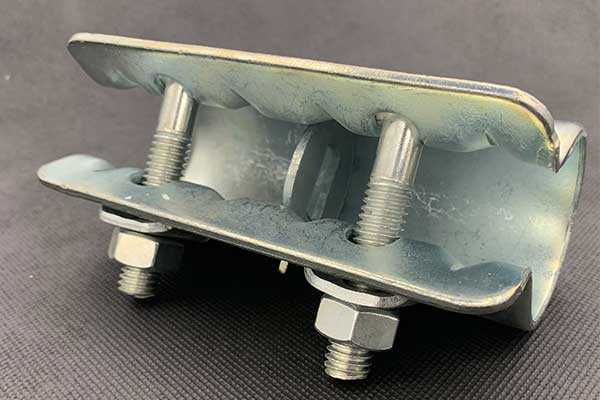
Key Features:
- Connects tubes end-to-end for extended length
- Reinforced with internal components for added stability
- Used when the scaffold needs to be lengthened
5. Board Retaining Couplers
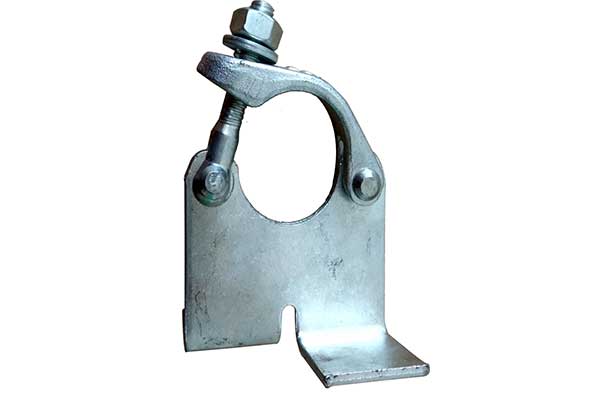
Board retaining couplers secure scaffold boards, preventing them from sliding off the scaffold. They are used to keep working platforms safe and stable by locking boards in place, which helps minimize accidents. This type of coupler is ideal in setups where there is a risk of boards slipping, especially on high scaffolds or in windy conditions.
Key Features:
- Ensures boards remain securely in place
- Increases worker safety on platforms
- Essential in high or windy conditions
6. Beam Couplers
Beam couplers are specialized couplers that connect scaffold tubes to beams or girders, providing a reliable structure for heavy-duty applications. They are primarily used in industrial scaffolding or heavy-duty construction projects where the scaffolding needs to support significant weight.
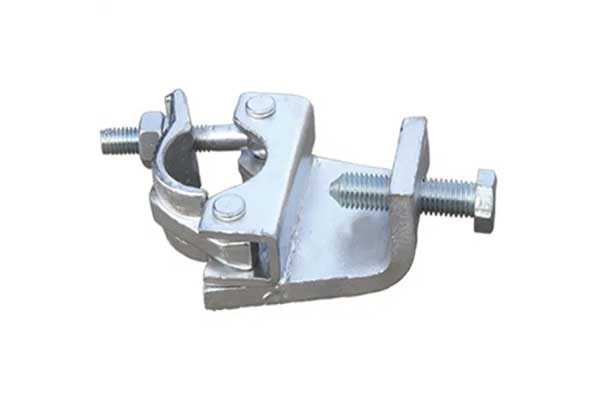
Key Features:
- Heavy-duty coupler for beam support
- Used in large-scale construction projects
- Enhances load-bearing capacity
Choosing the Right Coupler for Your Scaffolding Needs
Selecting the correct type of scaffolding coupler depends on several factors, including the scaffold’s design, load requirements, and specific project needs. Here are some key considerations when choosing scaffolding couplers:
- Load-Bearing Requirements: For load-bearing connections, such as the main framework, choose double couplers. For lighter, non-load-bearing connections, putlog couplers may suffice.
- Angle and Position Requirements: Swivel couplers are ideal for applications requiring angled joints, while right-angle couplers are best for 90-degree connections.
- Length Adjustments: Use sleeve couplers to extend the length of the scaffold, ensuring all tubes are securely connected.
- Environmental Conditions: In windy or high environments, consider using board retaining couplers to keep platforms secure and prevent accidents.
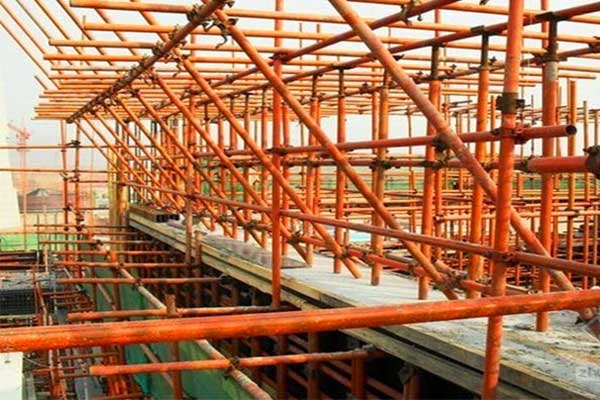
Benefits of Using Quality Scaffolding Couplers
Using high-quality scaffolding couplers can significantly impact project safety and efficiency. Here are some key benefits of investing in reliable scaffolding couplers:
- Enhanced Safety: Quality couplers reduce the risk of structural failure, ensuring that scaffolds can support the necessary weight and withstand environmental stresses.
- Project Compliance: Most construction sites are subject to strict safety regulations. Using certified scaffolding couplers helps meet safety standards and avoid potential fines.
- Durability and Longevity: Quality couplers are made from corrosion-resistant materials, increasing their lifespan and reducing maintenance costs over time.
- Adaptability: Various coupler types allow for flexible scaffolding configurations, ensuring that scaffolds can be adapted to meet project-specific requirements.
FAQs
Yes, combining different types of couplers within a single scaffold is common to meet specific structural and stability needs. For example, right-angle couplers can form the main framework, while swivel couplers may be used for angled braces. Just ensure all couplers are compatible with each other and meet required standards.
Most scaffolding couplers are designed to fit standard scaffolding tube sizes, typically 48.3mm in diameter. However, it’s essential to verify the tube and coupler specifications before assembly to ensure compatibility and safety.
Scaffolding couplers are generally made from steel or alloy materials due to their durability, load-bearing strength, and resistance to environmental factors like rust. Using high-quality materials ensures the couplers can withstand heavy loads and harsh weather, which enhances safety and prolongs the lifespan of the scaffold.
The weight capacity of a scaffolding coupler varies based on its type and material. Right-angle couplers, for example, can bear heavier loads, while putlog couplers are for lighter connections. Always check the manufacturer’s specifications for weight limits, and ensure they align with your project’s load requirements.
Scaffolding couplers should be inspected at least weekly, and more frequently if exposed to harsh weather conditions or heavy usage. Inspections should also be conducted after installation, any significant load shift, or any impact or damage to the scaffold structure.
Scaffolding couplers should meet national and international standards, such as OSHA in the U.S., BS EN 74-1:2005 in Europe, or other regional regulations. Adhering to certified standards ensures that the couplers are safe, reliable, and suitable for use in construction.
Scaffolding couplers are generally reusable as long as they are in good condition. However, they should be thoroughly inspected for damage, rust, or wear after each use. Damaged or worn couplers should be replaced immediately to maintain scaffold safety.
Scaffolding coupler costs vary based on type, material, and brand. Simple putlog couplers may be cheaper, while heavy-duty beam or right-angle couplers often cost more. High-quality, certified couplers may come at a premium but offer enhanced durability and safety.
Conclusion
Scaffolding couplers are indispensable components in any scaffolding system, providing secure and versatile connections that enable scaffolds to be configured to various designs. By understanding the types and applications of scaffolding couplers, construction teams can ensure that their scaffolding structures are safe, compliant, and efficient.
Shelter and Scaffolding Couplers
Shelter is a high-quality scaffolding couplers supplier, dedicated to delivering products that meet stringent safety and quality standards. Our scaffolding couplers comply with ISO, CE, BS1139, EN74, and other internationally recognized standards and certifications, ensuring reliable performance and safety on every project. Contact us for more information.
